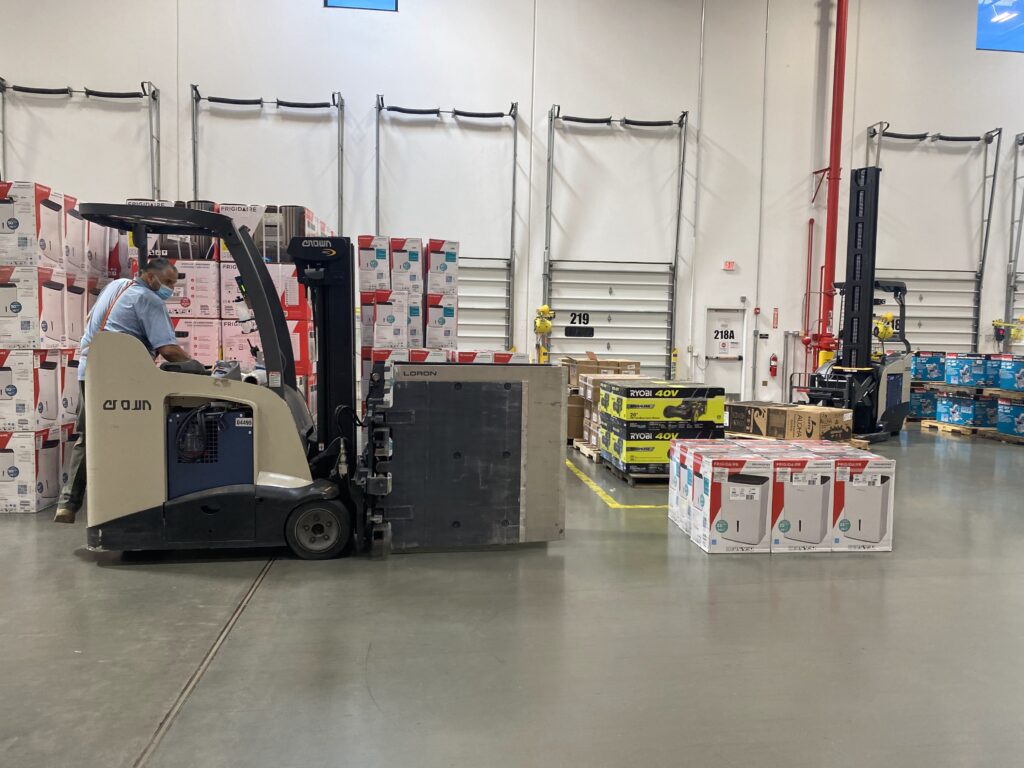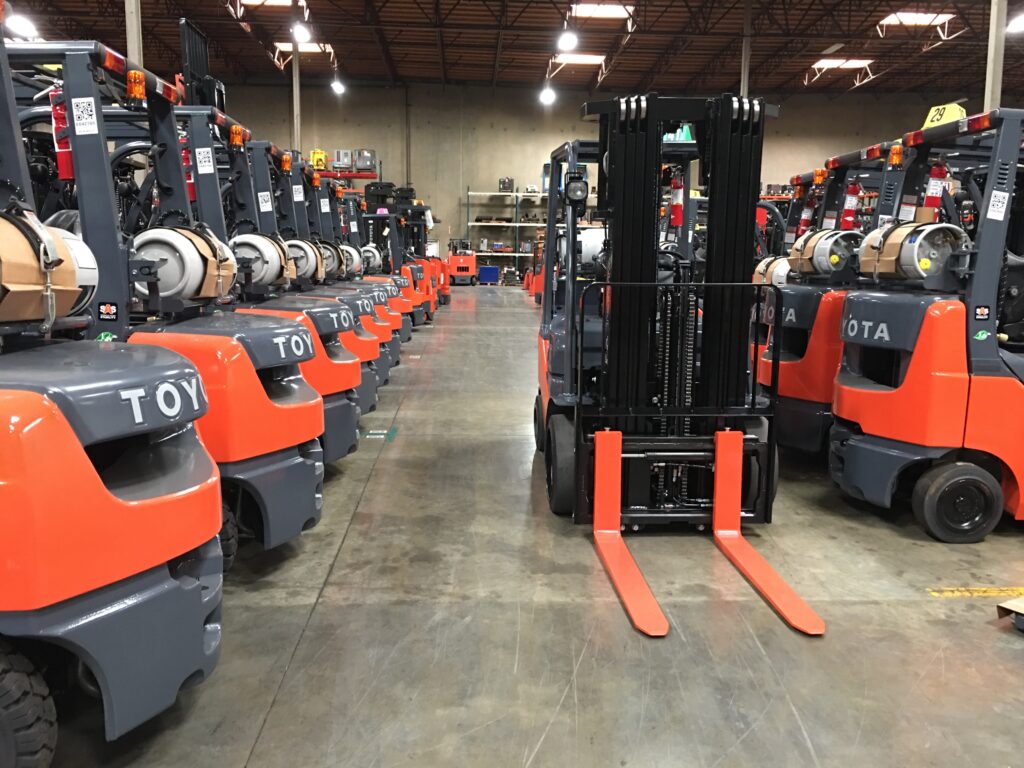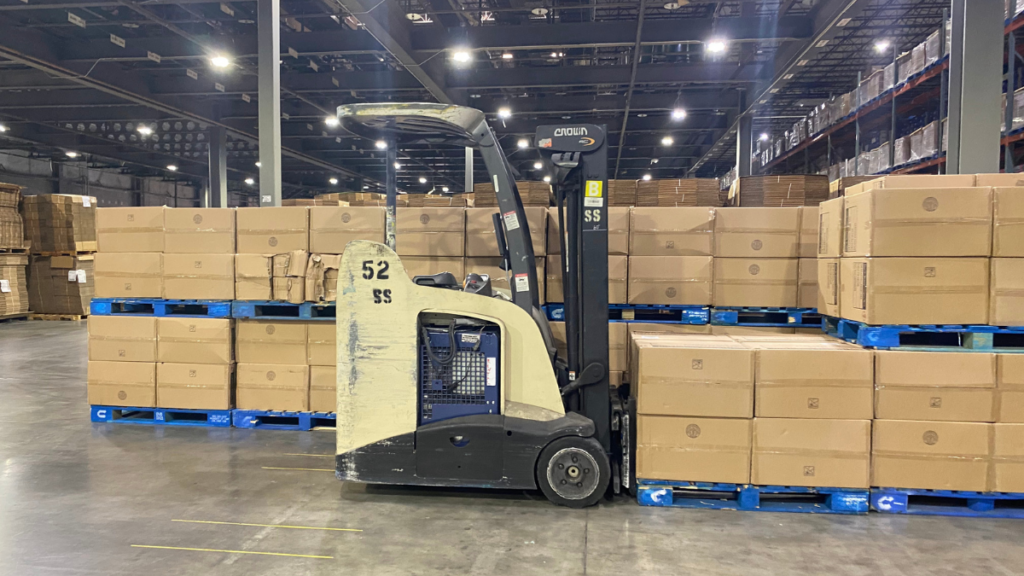Hydrogen fuel cells have ignited a transformation in the material handling landscape. This article explores the game-changing potential of fuel cells in material handling applications, discussing how this innovative technology can reshape operational efficiency, bolster safety measures, and support a cleaner, more sustainable future.
Harnessing the Power of Green Hydrogen
With the global shift toward sustainability, many businesses have embraced using clean energy in their operations. Options like green hydrogen have become increasingly popular in recent years.
By leveraging renewable sources such as wind, solar, hydroelectric, and nuclear power, companies can produce cost-effective, zero-carbon green hydrogen. Fuel cells convert the hydrogen fuel into clean electricity, which can power material handling equipment, vehicles, and various industrial applications. This enables industries to integrate green hydrogen into their operations, supporting sustainability goals and contributing to a cleaner energy landscape.
The versatility of hydrogen fuel cells makes them a key player in the transition to more environmentally friendly energy solutions. However, implementing sustainable technology must extend beyond environmental advantages to encompass the ease of implementation and economic efficiency. This helps enhance business productivity and worker safety while reducing electricity consumption.
Transforming Operations: When Batteries No Longer Suffice
Lead-acid batteries are the standard power source in many material handling applications. These rechargeable batteries use a chemical reaction between lead oxide and sulfuric acid to generate power for industrial equipment and vehicles.
Lead-acid batteries are recyclable, powerful, and inexpensive to purchase and install. The technology is also mature and well-understood, making it a reliable option. However, they present operational and environmental challenges, which can hinder productivity in material handling applications.
One of the major areas where lead-acid batteries fall short is efficiency. The batteries require several hours of charging before use, which increases downtime. The charging areas also tend to be large, limiting the usable space in material handling facilities.
By contrast, fuel cells offer fast refueling times, typically taking just a few minutes. This quick turnaround is advantageous for material handling operations, ensuring minimal downtime and maximizing productivity. Refueling stations also take up significantly less space than charging stations, freeing up valuable real estate that can enhance operational efficiency.
Unlike lead-acid batteries, which can experience performance degradation as they discharge, hydrogen fuel cells provide a consistent power output until the hydrogen supply is depleted. This feature ensures the stable performance of material handling equipment, contributing to efficient and predictable operations.
Both devices offer sustainability advantages. Hydrogen fuel cells are virtually emission-free. They generate electricity through an electrochemical reaction between hydrogen and oxygen, emitting only water and heat as by-products. This makes fuel cells particularly suitable for indoor material handling operations where air quality is a concern. Using green hydrogen further reduces a company’s overall carbon footprint.
Lead-acid batteries are reusable and highly recyclable, with a well-established recycling infrastructure. However, they contain toxic chemicals (sulfuric acid and lead), which can contaminate soil or water if not managed properly.
The chemicals can also pose health hazards. Sulfuric acid is corrosive and can cause severe burns if it comes into contact with the skin or eyes. Additionally, exposure to lead can cause long-term health issues in adults (e.g., cardiovascular problems, kidney damage, etc). However, proper handling, maintenance, and disposal practices mitigate most risks.
Like hydrogen fuel cells, lead-acid batteries produce little to no carbon emissions. However, overheating, over-charging, and battery degradation can lead to the release of by-products like hydrogen. Hydrogen is non-toxic, but in enclosed spaces, the buildup of hydrogen gas can create an explosive atmosphere. Therefore, proper ventilation and safety measures are crucial for safe usage of lead-acid batteries. This is important for fuel cells as well since hydrogen leaks can occur.
Hydrogen fuel cells also have a longer cycle life compared to lead-acid batteries. They can sustain larger numbers of charge and discharge cycles before experiencing a significant decline in performance. The simplicity of the fuel cell design, the absence of moving parts, and fewer components subject to wear and tear also contribute to its longevity.
Hydrogen solutions are becoming a practical choice over traditional lead-acid batteries for fleet operators in distribution, manufacturing, and warehouses. With the right hydrogen systems, operators can increase productivity, reclaim revenue-generating space, enhance employee safety, and refuel faster.
Hydrogen considerations
Hydrogen fuel cell technology has substantial environmental and productivity advantages, excelling in many areas where lead-acid batteries fall short. However, it is not without its challenges. The primary considerations are cost and refueling infrastructure.
Hydrogen fuel cells are currently more expensive to manufacture and implement than lead-acid batteries. And, the initial investment cost can be a significant barrier to adoption for businesses. However, fuel cells can help reduce long-term costs.
For example, although lead-acid batteries are cheaper, their limited cycle life may lead to more frequent replacement, adding to long-term costs. Fuel cells have fewer components susceptible to wear and tear, which can contribute to lower maintenance costs.
Hydrogen fuel cells also face infrastructure challenges. Fuel cell technology has not been around for as long as lead-acid batteries. Therefore, the infrastructure for hydrogen refueling is less widespread than traditional charging stations.
The limited availability of hydrogen refueling stations may restrict the widespread adoption of fuel cell-powered material handling equipment. However, as the technology continues to mature and gain traction, prices are expected to decrease, and refueling options will become more readily available for commercial and personal use, making the long-term economic viability more promising.
Industry Transformations: Success Stories
This section looks at fuel cell success stories from various industries, revealing how companies have cut emissions and increased efficiencies by adopting hydrogen and fuel cells. These case studies demonstrate the tangible benefits and transformative potential of incorporating hydrogen technology into material handling operations.

Warehousing
Material handling equipment is integral to the success of many industrial workplaces. Therefore, access to efficient and reliable energy is required to ensure optimal machine function. However, this can be more or less challenging in specific temperature conditions.
Lead-acid batteries in cold environments (e.g., freezers) pose issues like inconsistent power, long charging times, space requirements, and toxicity. This hinders productivity, resulting in operational inefficiencies.
FreezPak, a frozen food distributor in New Jersey, faced similar problems with the lead-acid batteries in their forklifts. Operators had to take multiple breaks throughout the day to fast charge the forklift batteries. The power issues meant workers had to choose between using full power for moving inventory or heating the backrests.
Seeking a solution, FreezPak turned to hydrogen fuel cells to replace their lead-acid batteries. The switch resulted in:
- Lowered electricity bills
- The elimination of battery rooms (saving floor space)
- Increase in volume of product moved during shifts
- An annual productivity boost
- Continuous full operating power
- Completed two-minute refueling each shift
FreezPak has since expanded its hydrogen fuel cell infrastructure. In late 2022, they entered into an agreement with Plug Power to supply fuel cells and nearly 400 hydrogen lift trucks to nine additional FreezPak sites.
Food and Beverages
In the food and beverage industry, forklifts are crucial, demanding reliability and safety. Traditional batteries pose challenges such as space consumption and productivity gaps during recharging. Two notable companies, Wegmans Food Markets, and Tyson Foods, tested hydrogen fuel cell solutions to enhance their material handling operations. This is discussed below.
Wegmans Food Markets
The company was tasked with developing a new refrigerated and frozen distribution center. The goal when planning was to improve productivity, optimize labor, reduce battery inventory space, and decrease maintenance costs.
Wegmans conducted a six-week trial comparing fuel cell-powered trucks with lead-acid battery trucks. They found that the trucks powered by hydrogen fuel cells were lower maintenance and encouraged machine operators to be more self-sufficient. This resulted in substantial operational savings, prompting the company to implement fuel cells in 83 forklifts in 2010. The fleet of hydrogen fuel cell-powered forklifts grew to 400 by 2021.
Tyson Foods
Tyson Foods faced productivity issues with lead-acid batteries in their cold storage facilities (e.g., charging time, power drops, etc.). They wanted to find a way to solve these issues while lowering operational costs.
The company decided to switch the lead-acid batteries in some of their lift trucks to hydrogen fuel cells.
After a six-week trial period, Tyson Foods achieved significant productivity gains, saved manual labor hours, and achieved two to three-minute refueling times for fuel cell tanks. They also experience no power drops in colder temperatures (34°F to -20°F).
Retail Industry
In the retail industry, many companies have embraced fuel cells to align with sustainability goals, focusing on equipment, space, and operator productivity metrics. Some prominent examples include Walmart, Amazon, and Home Depot.
Walmart:
- Operates over 10,000 hydrogen fuel cell-powered forklifts since 2012 across numerous distribution and fulfillment centers.
- Achieved significant improvements in warehouse space savings, electricity consumption, operator and equipment productivity, and sustainability.
- Collaborating with Engie, Walmart Chile developed and opened a green hydrogen plant at its Quilicura Distribution Center in Santiago, Chile, to support the company’s path to net-zero emissions.

Amazon:
- In 2019, Amazon introduced its Climate Pledge, a commitment to be net-zero carbon across all business operations by 2040. They also aim to power operations with 100% renewable energy by 2025.
- Has implemented hydrogen storage and dispensing systems in more than 70 fulfillment centers. These systems are being used to power over 15,000 fuel-cell-propelled forklifts, with plans to grow that number to 20,000 across 100 fulfillment centers by 2025.
- Signed an agreement with Plug Power to supply 10,950 tons per year of green hydrogen starting in 2025. It will provide enough annual power for 30,000 forklifts or 800 heavy-duty trucks used in long-haul transportation.
- Ordered zero-emission hydrogen electric yard tractors from Gaussin to be used at Amazon U.S. sites.
- Continues to test the use of hydrogen applications, such as fuel-cell electric trucks and fuel-cell power generation stations, to support efforts to decarbonize its operations and replace gray hydrogen, diesel, and other fossil fuels with clean alternatives.
Home Depot:
- Has deployed over 3,000 fuel cells with associated hydrogen infrastructure.
- Hydrogen fuel cell solutions reduced labor costs and downtime, increased productivity and vehicle range, optimized floor space, and monthly savings on electricity bills.
- Reduced environmental impact through zero-emission hydrogen fuel.

Automotive industry
Hydrogen fuel cells have emerged as a transformative technology for the automotive industry, offering numerous advantages in both manufacturing practices and vehicle use.
Like the other examples, implementing fuel cell technology into material operating equipment (e.g., forklifts) for auto manufacturing boasts benefits such as increased productivity, reduced downtime, lowered electrical bills, etc.
Many automotive manufacturers have also engineered hydrogen fuel cell vehicles. Unlike traditional internal combustion engines, these vehicles generate electricity through a clean and efficient electrochemical reaction, emitting only water vapor as a byproduct. This contributes significantly to the reduction of greenhouse gas emissions and air pollution.
Hydrogen fuel cell vehicles also offer an extended driving range, compared to battery electric vehicles, and quick refueling times, making them suitable for long-distance travel and commercial applications. Their adoption signifies a shift toward eco-friendly practices, reduced dependence on fossil fuels, and a commitment to mitigating environmental impacts.
Below are examples of hydrogen fuel cell advancements and achievements of major automotive companies.
BMW:
- Developing and testing the iX5 Hydrogen SUV, which supports their vision for a hydrogen-powered future in both private and commercial vehicles. In late 2023, the vehicle demonstrated strong performance during hot-weather testing in UAE.
- Has one of the largest hydrogen fuel-cell fleets (over 900 pieces of equipment) in the world on a single site, at its Spartanburg facility in South Carolina. Since implementing this fleet, the facility has experienced increased productivity, less wasted floor space (by eliminating battery rooms), and more sustainable operations with little to no toxic emissions.

Toyota:
- Supplying hydrogen fuel cell vehicles for the 2024 Olympics, showcasing their commitment to sustainable transportation on a global stage.
- Unveiled electric and hydrogen-powered concept models of its classic AE86 car.
- Launched a hydrogen demo truck, which integrates Toyota fuel cell technology into VDL’s heavy-duty trucks, to support Toyota’s efforts to decarbonize operations in Europe.
- Implemented hydrogen fuel cell forklifts in their manufacturing facilities, demonstrating the applicability of fuel cell technology in industrial settings for enhanced efficiency and reduced environmental impact.
Hyundai:
- Introduced the Nexo, a hydrogen fuel cell SUV offering improved performance and an extended driving range for private use.
- Unveiled the N Vision 74, a hybrid hydrogen fuel cell, battery-electric vehicle concept.
- Its fleet of XCIENT Fuel Cell heavy-duty trucks in Switzerland accumulated more than 5 million km in two years.
Honda:
- Launched the Clarity Fuel Cell sedan for private use, contributing to the expansion of hydrogen-powered options in the automotive market.
- Formed a technological research association with Kawasaki, Suzuki, and Yamaha, called HySE, for developing hydrogen-powered engines for small mobility vehicles.
Mercedes-Benz:
- Developed the GLC F-CELL, a hydrogen fuel cell vehicle for private use, combining innovative technology with sustainable transportation.
General Motors:
- Collaborated with the U.S. Army to develop a hydrogen fuel cell-powered Chevrolet Colorado for military use, showcasing versatile applications.
Daimler Trucks:
- Introduced the Mercedes-Benz GenH2 Truck, a heavy-duty hydrogen fuel cell truck designed for commercial freight transport, addressing sustainability in the logistics sector.
Charting the Course for a Hydrogen-Powered Future in Material Handling
Hydrogen, particularly in its green form, continues to emerge as a powerhouse solution for material handling operations, reshaping operational landscapes and propelling industries toward a cleaner and more sustainable future.
The limitations of traditional lead-acid batteries become apparent, especially in high-utilization, multi-shift fleet scenarios. Hydrogen fuel cells rise to the occasion, offering faster refueling times, efficient use of space, and consistent power output, ensuring seamless operations.
The success of hydrogen fuel cell integration in several fields underscores the tangible benefits experienced by companies embracing hydrogen fuel cells, from lowered electricity bills to increased productivity and reduced environmental impact.
While acknowledging the current challenges of cost and refueling infrastructure, the trajectory of hydrogen fuel cell technology appears promising. As prices decrease and infrastructure expands, the economic viability of this clean energy solution is poised to become more accessible for widespread adoption.





